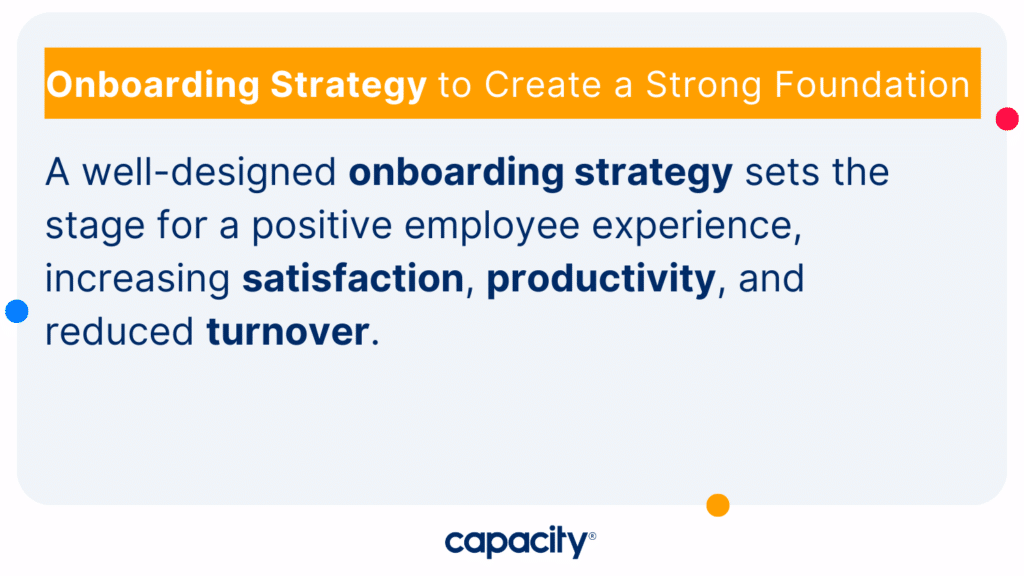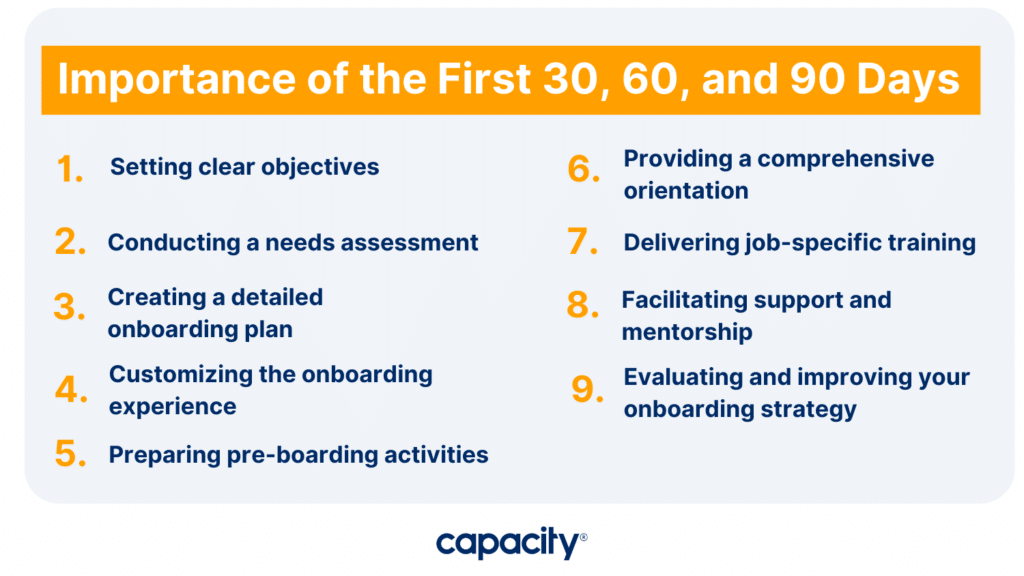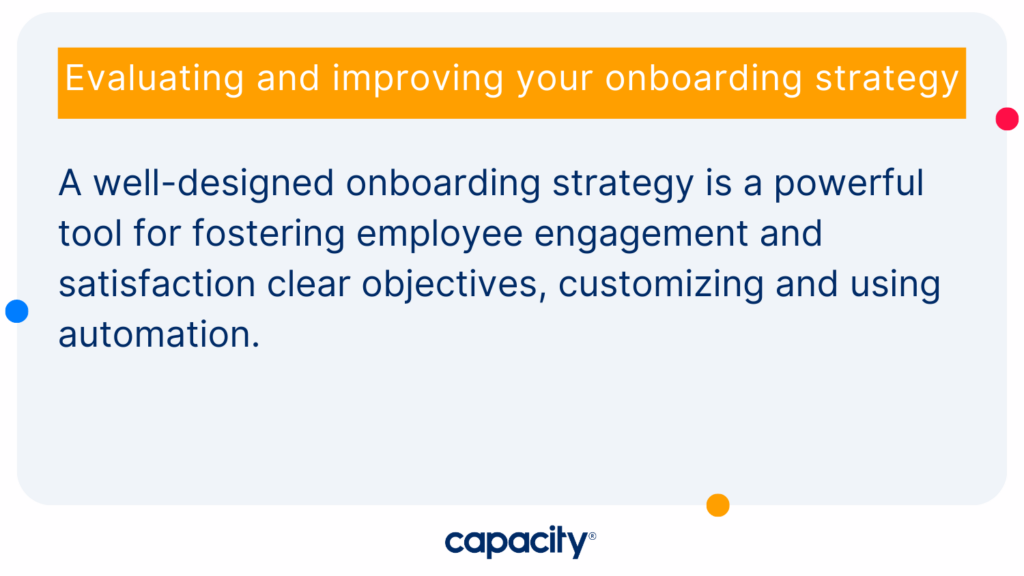
Understanding the importance of employee onboarding is paramount for long-term employee retention and engagement. A well-designed onboarding strategy sets the stage for a positive employee experience, increasing satisfaction, productivity, and reduced turnover. In this article, we will explore the links between onboarding and employee engagement, satisfaction, and retention, supported by research. Additionally, we will provide a step-by-step guide on how to build a strong onboarding strategy. Let’s look at the role of automation, a good internal helpdesk, and knowledge management in making the onboarding process more efficient and effective.
The importance of the first 30, 60, and 90 days for a new employee

The initial days of a new employee’s journey within your company are critical for their integration, engagement, and overall satisfaction. Research shows that employees who have a positive onboarding experience are more likely to stay with the company long-term and become engaged contributors. Let’s explore why the first 30, 60, and 90 days matter in a step-by-step guide.
1. Setting clear objectives
In the first step of building a strong onboarding strategy, it is crucial to define clear objectives. Identify the goals and outcomes you want to achieve through your onboarding process. By incorporating automation into the onboarding workflow, you can streamline administrative tasks. Reduce paperwork and documentation and allow new hires to focus on building relationships and understanding their roles in greater depth.
2. Conducting a needs assessment
To create a personalized onboarding experience, it’s essential you understand the specific needs and requirements of your organization and new hires. Firstly, analyze your existing onboarding practices and identify areas for improvement. Automation can assist in gathering data and feedback from new hires. In turn, this helps you identify pain points and areas of improvement in the onboarding process.
3. Creating a detailed onboarding plan
A comprehensive onboarding plan is crucial for a smooth transition and successful integration of new hires. So, you’ll want to develop a detailed plan that outlines the onboarding process from pre-boarding to long-term integration. Use automation to create workflows and timelines. Assign responsibilities to key stakeholders, ensuring that each step is completed in a timely manner.
4. Customizing the onboarding experience
Every new hire is unique, and their onboarding experience should reflect that. Therefore, tailor the onboarding process to meet the specific needs of different roles, departments, and levels within your organization. In fact, newly hired employees are 58% more likely to still be at the company three years later if they had completed a structured onboarding process. So consider the individual backgrounds. Regard the skill sets and learning styles of your new hires and use automation in personalizing the onboarding experience.
5. Preparing pre-boarding activities
Engaging with new hires before their official start date is an effective way to create excitement and anticipation. Provide them with the necessary paperwork, orientation materials, and resources in advance. Automation can simplify this process by automating the delivery of pre-boarding materials. Give access to online portals or knowledge bases where new hires can learn about your company culture and values.
6. Providing a comprehensive orientation
Orientation sessions are an integral part of the onboarding process. During these, new employees can get acquainted with your company’s culture, values, mission, and vision. Using automation tools, internal knowledge bases, and chatbots can simplify the orientation process. These resources can provide easy access to information. They help to answer frequently asked questions and guide new hires through your company policies and procedures.
7. Delivering job-specific training
To ensure that new hires have the necessary skills and knowledge for their roles, design and deliver targeted training programs. Automation can play a significant role in providing access to training materials, resources, and tools through automated guides and a strong internal knowledge base. In effect, this allows new employees to learn at their own pace and refer back to resources whenever needed.
8. Facilitating support and mentorship
Assigning mentors or buddies to new hires can greatly enhance their onboarding experience. A study by the Aberdeen Group of senior executives and HR staffing and recruiting functions found that 86% of respondents felt that a new hire’s decision to stay with a company long-term is made within the first six months of employment. Mentors can guide and support new employees during their initial period, providing a safe space for questions, concerns, and feedback. Then, establish regular check-ins and feedback sessions to address any challenges and provide constructive guidance.
9. Evaluating and improving your onboarding strategy
Continuous improvement is essential for an effective onboarding strategy. Gather feedback from new employees, managers, and stakeholders to evaluate the effectiveness of your onboarding program. Use surveys, interviews, and performance metrics to assess the impact of your onboarding efforts and identify areas for refinement. Automation tools can assist in collecting and analyzing data to make data-driven decisions.

A well-designed onboarding strategy is a powerful tool for fostering employee engagement and satisfaction. By defining clear objectives and customizing the onboarding experience, you can create a strong foundation for new employees’ long-term success. Investing in an effective onboarding process not only benefits the employees but also contributes to the overall success of the organization. Implement the steps outlined in this guide. Then, watch your onboarding strategy transform into a catalyst for employee engagement and satisfaction.
Automate your onboarding strategy with Capacity. Try your 30-day free trial today!

Automate Your Work
Capacity’s enterprise AI chatbot can help:
- Answer FAQs anytime, anywhere
- Find relevant documents within seconds
- Give surveys and collect feedback





